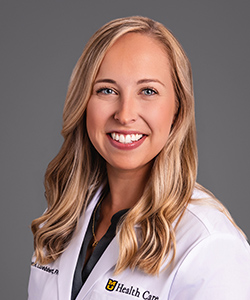August 20, 2025

Urgent care and quick care facilities are popping up everywhere, making it easy to get non-emergency care any time. Have a sinus infection, a stubborn cough or a rash that won’t go away? You can run to urgent care for a diagnosis and prescription on your way to pick up groceries.
Modern health conveniences and care when you need it are always a good thing. But if you’re just hitting up a walk-in care clinic when you have a problem instead of finding a primary care provider (PCP), you might be missing out on some long-term health benefits.
So, what’s the big difference between a place like quick care or urgent care and a primary care clinic? After all, they can all diagnose common ailments and prescribe treatment, right?
It’s a little more complicated than that, says MU Health Care family nurse practitioner Miranda Luebbert. Luebbert, who spent years working in urgent care before switching to a primary care practice, says primary care is more focused on the big picture of your health.

Both primary care and walk-in care facilities can treat you in the moment for a sudden ailment. But primary care takes a comprehensive view of you and your health to catch medical issues in their early stages. When you visit quick care or urgent care with symptoms, you’re already behind the eight ball. Instead of preventing a health issue, you now need to solve a problem.
“It’s about deciding which side of a health condition you want to target,” Luebbert says. “For example, you can either find out you have diabetes once you already have symptoms, or you can catch it before you are symptomatic, when your blood sugar is only slightly high, and prevent it from getting worse.”
Luebbert adds that there is certainly a place for both urgent and primary care when it comes to staying healthy. But understanding why you need primary care — and establishing it at a young age — can lead to better health over time.
Benefits of Having a Primary Care Provider
Young adults may choose quick or urgent care because it seems more convenient and affordable. But having a PCP in place also has benefits, including:
1. Provides Continuity of Care
In a survey, 25% of all adults reported that they don’t have a PCP. That number becomes more extreme depending on age — nearly half of adults under age 30 don’t use primary care, while only 12% of adults age 65 and older live without an established primary physician.
The reason so many older adults have a PCP is often because their primary doctor manages their chronic conditions. However, having a PCP in place early may prevent those chronic conditions from developing in the first place.
“What young adults may not realize is that diseases can take months, years and decades to creep up on you,” Luebbert says. “That’s where a PCP comes in — they are assessing your health over time and can spot concerning changes and address issues early.”
If you live with a chronic disease, such as high blood pressure or depression, a PCP manages your medications. They assess kidney function to ensure the medication isn’t causing harm. They monitor interactions between multiple treatments and medications. They also provide care based on your health history, values and preferences because they know you as an individual.
2. Ensures You Get Preventive Screenings
Research shows adults with primary care are more likely to have a routine preventive visit each year.
“Primary care initiates all of your preventive screenings,” Luebbert says. “When you catch diseases, such as diabetes or high blood pressure, in the early stages, you may be able to treat them with lifestyle modifications instead of jumping right into medication. Early diagnosis and treatment also tend to provide better outcomes.”
Preventive medicine is not just about cancer screenings and heart health. PCPs perform skin checks, assess vital signs, evaluate sight and hearing, and screen for mental health issues. Primary care also provides access to immunizations and lifestyle counseling that can lower your risk for illness, infection and disease.
3. Connects You With Specialists
Let’s be real, at some point in your life, you will likely see a specialist for a health concern. A study of over 70,000 adults in the United States found that 46% of those surveyed saw a specialist in the past year.
PCPs recognize the need for a specialist. Luebbert provides the example of having a sinus infection. You may go to urgent care and receive the treatment you need. But what that urgent care doctor may not realize is that this is your sixth sinus infection and sixth course of antibiotics this year. Your PCP will know that and potentially prescribe something different or connect you with an ear, nose and throat specialist who can get to the bottom of the issue.
In some instances, a primary doctor can also help you get an appointment with that specialist quickly. “Having a primary care provider can often help you access a specialist without having to wait months for an appointment,” Luebbert says. “Let’s say a skin lesion is caught in a routine screening. A PCP could save you years of potential skin cancer progression by getting you into a dermatologist right away.”
4. Offers Easy Access to Consistent Medical Care
Urgent or quick care may seem like the fastest way to see a provider — and it often is on weekends or holidays. But once you are established with primary care, you’ll also have convenient access, and to a provider who you’ve seen before.
“Primary care offices typically have several time slots set aside throughout the day for same-day in-person or virtual visits,” Luebbert says. “You can also utilize the patient portal to send a message directly to your provider, without leaving home or work. You should receive a reply within an hour or two, and the medical advice you receive will take your health history into account.”
Tips for Finding a Primary Care Provider
The best primary care is the one that you’ll actually use — that means you need to be comfortable, and the care needs to be convenient.
Luebbert recommends taking these steps when looking for a PCP:
- Narrow your search, based on what makes you comfortable, such as sex, gender, language spoken or age.
- Check for convenience by noting the location, hours and types of appointments offered.
- Look at the physician profile to get a better understanding of the provider’s focus and general approach to primary care medicine.
- Ask for recommendations from friends, family and even the urgent care, because they may know which local providers are accepting new patients.
“It may take time to get set up with a PCP,” Luebbert says. She adds that it could be months before the provider can see you, but once you are an established patient, you’ll take priority over newer patients. “It will be worth the wait. Patching your care together at urgent care will never provide the cohesive attention you’ll get with a PCP spearheading your health care and tailoring it to you.”
Next Steps and Useful Resources
- Ready to establish care with a PCP? Find one today.


